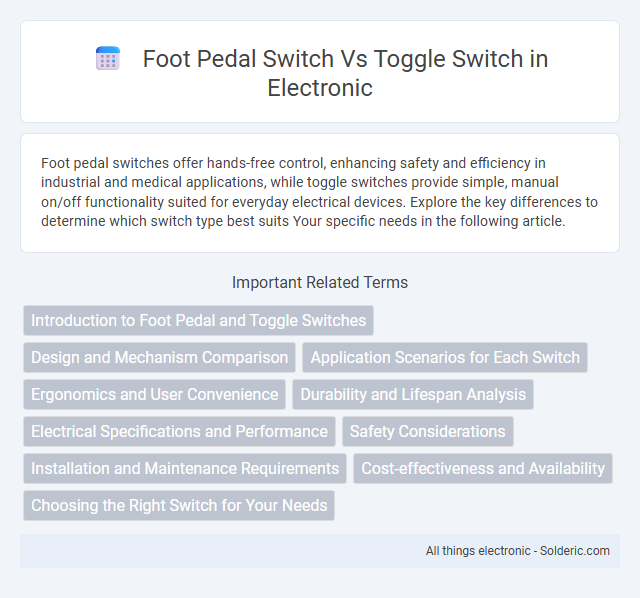Foot pedal switches offer hands-free control, enhancing safety and efficiency in industrial and medical applications, while toggle switches provide simple, manual on/off functionality suited for everyday electrical devices. Explore the key differences to determine which switch type best suits Your specific needs in the following article.
Comparison Table
| Feature | Foot Pedal Switch | Toggle Switch |
|---|---|---|
| Operation Method | Activated by foot pressure | Activated by hand lever toggle |
| Use Case | Hands-free control in machinery, sewing, medical devices | Manual on/off control in electronics and appliances |
| Ergonomics | Improves workflow with foot operation | Requires hand manipulation |
| Durability | Robust for heavy-duty and repetitive use | Moderate durability depending on design |
| Typical Voltage Rating | Often supports 12V to 250V AC/DC | Commonly supports 125V to 250V AC |
| Installation | Floor-mounted or portable | Panel-mounted or surface-mounted |
| Cost | Generally higher due to mechanical complexity | Typically lower cost |
Introduction to Foot Pedal and Toggle Switches
Foot pedal switches and toggle switches serve as essential control devices in various applications, offering distinct operational methods tailored to user needs. Foot pedal switches enable hands-free control by activating with pressure from the foot, making them ideal for tasks requiring manual dexterity. Toggle switches provide a simple, on-off switching mechanism operated by hand, commonly used in electrical circuits for reliably managing power flow.
Design and Mechanism Comparison
Foot pedal switches feature a larger, tactile surface activated by foot pressure, providing hands-free operation ideal for continuous or heavy-duty use, while toggle switches utilize a small lever moved manually to distinct on/off positions, offering compactness and simplicity. Foot pedal switches often employ a momentary or maintained contact mechanism that is robust against repetitive foot activation, whereas toggle switches rely on a mechanical latch system ensuring stable, discrete state retention. The ergonomic design of foot pedal switches enhances user comfort during extended operation, contrasting with the straightforward and space-efficient design of toggle switches suitable for compact control panels.
Application Scenarios for Each Switch
Foot pedal switches are ideal for hands-free control in industrial machines, medical devices, and sewing equipment, allowing precise operation without interrupting hand tasks. Toggle switches suit applications requiring straightforward on/off control, such as household lighting, automotive systems, and electronic devices, where easy manual switching is necessary. Each switch type optimizes user interaction based on the need for either foot actuation or hand-operated control in specialized or routine environments.
Ergonomics and User Convenience
Foot pedal switches offer superior ergonomics by allowing hands-free operation, reducing hand and wrist fatigue during prolonged use. Toggle switches require manual activation, which can interrupt workflow and cause discomfort in repetitive tasks. Your choice should consider how the switch design impacts ease of use and overall comfort in your specific application.
Durability and Lifespan Analysis
Foot pedal switches typically offer higher durability and longer lifespan due to their robust design, which is engineered to withstand frequent and forceful foot operations in industrial environments. Toggle switches, while reliable, often experience shorter lifespans when subjected to repetitive or heavy usage because their mechanical components are more prone to wear and tear. Choosing the right switch depends on your specific application demands, with foot pedal switches excelling in durability under continuous, high-impact conditions.
Electrical Specifications and Performance
Foot pedal switches typically handle lower voltage and current ratings, making them suitable for applications requiring momentary activation and hands-free control, offering precise control and durability under frequent use. Toggle switches often support higher voltage and current capacities, designed for on/off operations with firm mechanical feedback and long-term reliability in various electrical circuits. Your choice depends on the electrical load, switching frequency, and control style needed for optimal performance.
Safety Considerations
Foot pedal switches enhance safety by allowing hands-free operation, reducing the risk of accidental activation and improving operator control in machinery environments. Toggle switches, while convenient, require manual contact that can expose users to electrical hazards, especially in wet or industrial conditions. Implementing foot pedal switches in heavy machinery or production lines minimizes injury risks by keeping hands free and enabling quick emergency shutdowns.
Installation and Maintenance Requirements
Foot pedal switches typically require floor-level mounting and wiring, making initial installation more involved but offering hands-free operation, which is advantageous in industrial or medical environments. Toggle switches usually mount on panels or walls with straightforward wiring, allowing easier and quicker installation. Maintenance for foot pedal switches often involves regular cleaning and inspection due to exposure to dirt and foot traffic, whereas toggle switches generally need less frequent upkeep but may require periodic checking for mechanical wear or electrical contact issues.
Cost-effectiveness and Availability
Foot pedal switches typically offer greater cost-effectiveness for applications requiring hands-free operation, with prices generally lower than specialized toggle switches designed for similar functions. Toggle switches are widely available in numerous configurations, making them easily accessible for various standard electrical projects, albeit sometimes at a higher cost for heavy-duty or sealed versions. The decision between the two hinges on balancing budget constraints with specific functional needs and availability in local or online markets.
Choosing the Right Switch for Your Needs
Foot pedal switches offer hands-free control ideal for tasks requiring frequent on/off activation, enhancing efficiency in industrial and medical environments. Toggle switches provide reliable, manual switching with clear on/off positions suitable for simpler applications or where precise control is less critical. Your choice depends on whether your work demands foot-operated convenience or straightforward manual operation, ensuring optimal performance and ease of use.
Foot pedal switch vs Toggle switch Infographic

 solderic.com
solderic.com